Growing Pomegranates in Containers is the most practical way to relish this unique tropical fruit in a small space. It’s fun and easy!
Growing Pomegranates in Containers is possible because it has a shallow root system compared to other fruit trees. Besides that, it doesn’t take years to fruit and in a pot, you can control its environment by shifting it indoors in cold weather. The compact size is also suitable for balconies and patios–so here are all the details on How to Grow a Pomegranate Tree in a Pot and its Care!
Check out some interesting Pomegranate Peel Uses in the Garden here
Pomegranate Tree Information
Pomegranate trees, if grown under optimal conditions, live up to 200 years. Native to the Middle East, more specifically–Iran, and South Asia, Himalayan Northern India, it is a shrub or small tree that can grow up to 6 meters (20 feet) but usually stops around 2-3 meters.
They are of the size of apples with a yellow to reddish-brown, pink or rich red hard shell. The heavenly taste of pomegranate fruit is unique and can’t be compared to any other fruit in the world–sweet, aromatic, juicy, and crunchy.
USDA Hardiness Zones: 9b – 11, *can be grown below zone 9 in containers
Difficulty: Easy
Soil pH: Neutral
Other Names: Punic apple, Granatapfel, Granada, Grenade, Melograno, Melagrana, Anardana, Anar, Dadima, Fruit du, Pomme Grenade, Punica granatum, Roma, Shi Liu Gen Pi, and Shi Liu Pi
Learn How to Grow Sugar Apple here
Best Dwarf Pomegranate Varieties for Pots
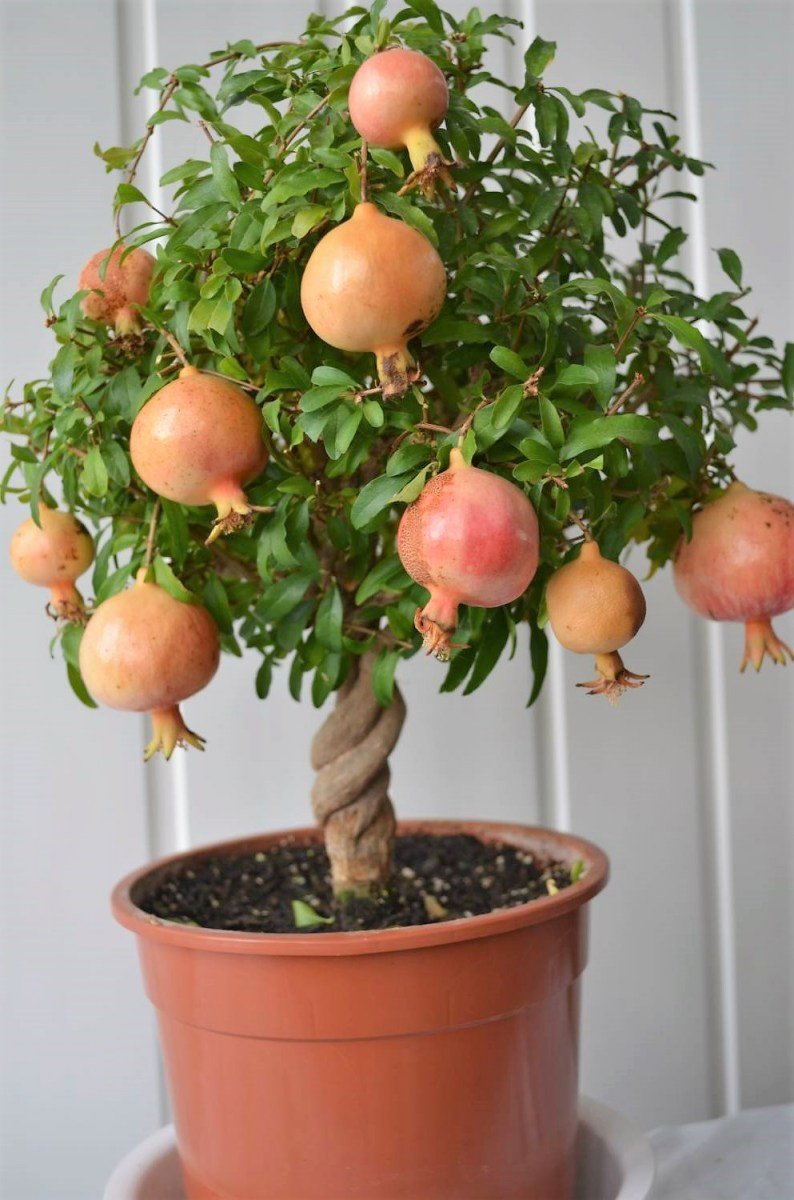
- Nana: It grows compact, floriferous, and is considered robust and cold hardy. It grows in USDA Zones 7 to 11.
- Provence: It can tolerate temperatures down to 5 F (-15 C) and can be grown in cold climates.
- State fair: State fair is a manageable variety for containers. It can grow up to 1.5 m tall in USDA Zones 7 to 11.
Some popular Iranian pomegranate cultivars are Sweet Alac, Sour Alac, Sour Malas, Sweet Black, Sour Summer, Sour White Peel, Sweet Saveh, Black Peel, Sweet White Peel, Agha Mohammad Ali, Sweet Shahsavar, Robab, Yousef Khani, and Sweet Aghdaei.
Some famous Indian varieties are Alandi or Vadki, Bhagwa, Dholka, Kandhari, Kabul, Muskati Red, Paper Shelled, Spanish Ruby, Ganesh (GB I), G 137, P 23, P 26, Mridula, Aarakta, Jyoti, Ruby, IIHR Selection, YCD1.
Check out the Dwarf Vegetables you can grow here
Best Ornamental Pomegranate Varieties for Pots
- Flore Pleno: It’s a fruitless variety of pomegranates and produces countless beautiful orange-red flowers.
- Madame Legrelle: The special thing about this variety of pomegranates is its extraordinary, dense double flowers in shiny orange to salmon colors with a white border.
Note: Pomegranate is a manageable plant. You can also try larger varieties in pots.
Check out the best Ornamental Plants for Shade here
Growing Pomegranates in Containers
Pomegranate plants can be propagated by cuttings or seeds from spring to summer when the temperature remains in the range of 68 F (20 C), but it is better to buy a 2-3-years old well-grafted plant from a reputed nursery or online. This way, you don’t have to wait long for fruits.
Propagation by Seeds
Buy as ripe pomegranates as possible. Separate and clean seeds from the pulp by rubbing them on a paper towel, let them dry up for a few days before sowing.
Plant the seeds no more than ¼ inches deep in a light seed-starting mix. Place the pots in a sunny location, optionally inside a plastic bag or greenhouse that maintains a temperature around 68 F (20 C).
Always keep the soil moist. Seeds will germinate within 1-6 weeks, depending on the variety and climate.
Propagation by Cuttings
Take several 8 to 10 inch-long cuttings and plant them in a well-draining potting mix. It roots easily and quickly at the ambient temperature of 20 degrees Celsius and high humidity.
Tip: Growing pomegranates is extremely easy for you if you live in the tropics. You can grow pomegranate in any season except peak summer.
Best Pot Size for Growing Pomegranates
Either start in a big pot like a wine barrel or half whiskey, large bucket or accommodate the plant in a standard 8 to 12 inches size container and gradually increase its size depending on your plant’s growth. Make sure that the pot has sufficient drainage holes at the bottom.
Requirements for Growing Pomegranates in Pots
Location
Choose the sunniest location to keep your pomegranate plant happy and healthy. The more sun it will receive, the more it will fruit. However, it also thrives in partial shade, but it makes the plant bloom and fruit lesser.
It is also possible to cultivate a pomegranate tree indoors near a windowsill if it receives full sun. Also, there should be good air circulation around it but make sure the location won’t be too windy or else the flowers will fall prematurely.
Soil
The University of Georgia states this plant grows best in loamy, sandy, and clayey soil. It is tolerant of moderately acidic to slightly alkaline soil and does best in a soil pH range of 5.5 to 7.2.
Pick a well-draining growing medium and add plenty of organic matter for the best fruits. Adding compost or well-rotted manure to the soil is also a good idea to improve soil texture and beneficial plant elements.
Watering
Water the plant well and keep the soil slightly moist all the time. Do not let the growing medium dry out completely. It would be best to water the plant when the topsoil feels a bit dry to the touch.
Avoid overhead watering and wetting the leaves as it will attract fungal issues.
Check out the Signs of Overwatering in Plants here
Pomegranate Tree Care
Fertilizer
During the growing season, fertilize the plant using a liquid 8-8-8 fertilizer. You can also go for the blend formulated for citrus trees or tomatoes.
A pomegranate tree in a pot often becomes zinc deficient, indicated by yellowing leaves. To overcome this, you can spray diluted zinc solution on foliage.
The application of compost or manure is also beneficial. Take care not to overfertilize with nitrogen-rich fertilizer as it can cause the tree to produce more foliage and comparatively fewer flowers.
Look out for the Symptoms of Nitrogen Toxicity in Plants here
Overwintering
Pomegranate is a deciduous tree that worships the sun. Most of its species are sensitive to frost. But for too low temperatures, the plant has developed a protective mechanism.
It sheds its leaves and becomes dormant below freezing temperature. Only a few pomegranate tree varieties survive freezing temperatures of more than -10 C (14 F) without damage, for that, you’ll have to research and experiment.
If the pomegranate is cultivated in a pot in a cold climate below USDA Zone 9–the best place to keep the pomegranate plant in winter is the greenhouse, garage or basement that remains warm. The indoor temperature should not fall below 37 F (3 C). However, the optimum low temperature for most pomegranate varieties is 7 C (45 F).
If you can keep your pomegranate tree at a temperature around 55 F (15 C) indoors and allow it to take at least 4 hours of sunlight, it will not shed its leaves and go dormant. During the period of dormancy, the pomegranate hardly needs fertilizer or water. However, the plant in winter should not dry out completely.
In spring, bring back the plant to a warm and bright place to gradually acclimate to the climate. A window that is oriented to the South is good. Once the temperature is 7 C (45 F), place it outside. When the plant shows the first sign of growth and forms a few fully developed leaves, you can start to fertilize it and give it more water.
Pruning
Pruning is necessary to maintain the desired shape of your pomegranate tree and encourage flowering and fruiting. It is best done after all danger of frost has passed when the tree is about to start growing in spring.
Prune off weak, dead, and undesirable branches to direct the shrub’s energy to the right parts and shorten long branches to encourage flowering.
Caveat: Some of the varieties have thorns; wear gloves before pruning for your safety.
Re-potting
Repot your pomegranate tree when it becomes slightly root-bound. The right time to repot is when there are no flowers or fruits on the plant, especially when it starts its growth at the beginning of the growing season.
Diseases, Pests, and Other Problems
The pomegranate tree is not very vulnerable to pests and diseases. It is mainly attacked by fruit flies, whiteflies, and pomegranate butterflies. You’ll also need to keep an eye on mealybugs and aphids–especially during the flowering period.
Fruit crack is one problem that is common in all pomegranate varieties. It occurs due to fluctuation or lack of moisture in a substrate during fruiting.
Harvesting Pomegranate
If pomegranate is grown from seeds, fruits will begin to form from the third or fourth year. Generally, the fruit will ripen three to six months after the appearance of flowers.
Harvest pomegranate when the crust of the fruit is intense red. Cut the fruit’s stem using sharp pruning shear or knife.


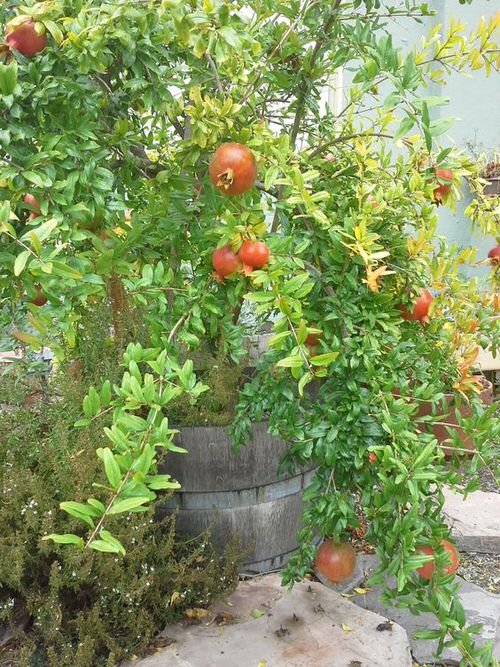
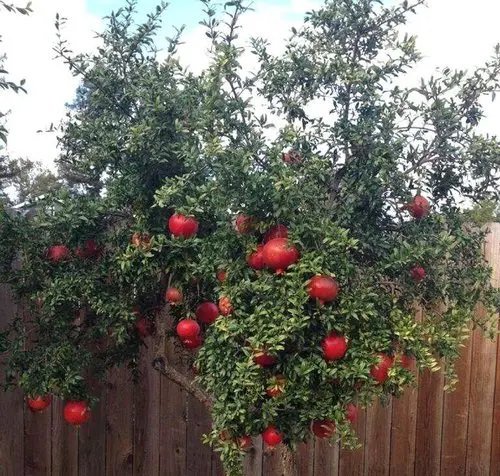
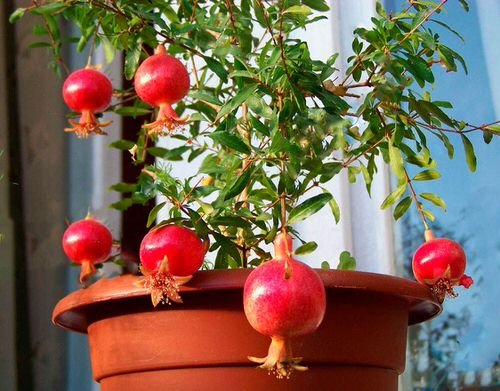
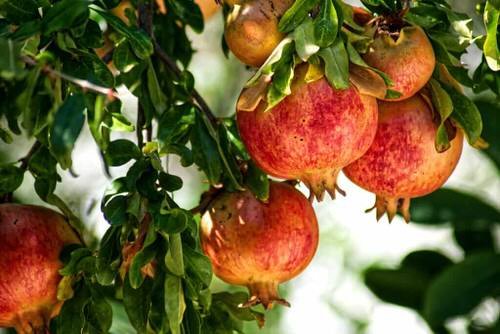

This article says that it is USDA zone 7-11, but the map to the right says 8-11. I have also found conflicting information on other sites. I am in zone 7, so clarification on this would be very helpful.
I grew pomegranate tree from seeds, it’s eight years old but no fruit yet. I feed, pruin & bring it inside during winter months. What else can I do to encourage fruiting? Please advice.
Best regards.
Unfortunately, fruit grown from seed may never produce fruit. Seed grown plants are more like a child to the parent plant but plants taken from cuttings are more like a clone of that parent. If you have waited to your wits end, it may be time to replace that tree with a new one taken from cutting or grafted. Hope this helps you.
Perhaps it needs a male or a female to go with it. tomatoes are self-pollinating meaning they have both male and female parts but you need two take a cue tip and go from flower to flower in order to have them self pollinate as a bee would do. I’m not sure about pomegranates. You could read up on them
It seems your variety is not self fertilising so you need to have a other plant nearby to help pollinate it
This is a great idea.I live in Virginia and ten minutes from North Carolina so I will be able to plant inside and outside. I absolutely love pomegranates and always look forward to seeing them in our grocery stores before thanksgiving .
I am going online now and find a plant . Thank you for inspiring me to try something new.
I made a huge mistake. Transplanted a young pomegranate tree in August here in CORPUS CHRISTI. Afraid it’s a goner. Bought a potted one and plan to put it in the ground late March. Sigh.
I have a pomegranate tree which flowers but does not change to fruit.What should I do
I live in BC Canada, can I grow pmegranits outside. Our weather is mostly wet, snow and ice in winter. I live in a townhouse so do not have the room to bring plants inside. Summers are usually sunny but can change at the drop of a hat. I have a patio that faces north and gets late afternoon sun, the side garden faces west. I have two large pots at the front, facing south and have patio raspberry in one that has done very well for three years now.
it took mine from seed approx 6 to 7 yrs, it does not like too much water as it has shallow roots. it needs fertilizer, half strength , twice a month. no fertilizer in winter, less water in winter. they are supposed to be self fertile however, once it flowers, you can use the q tip method or a small paintbrush like for art, and brush the q tip or paintbrush along the pistils of the flowers from one to another. this type pollinates w wind and birds, but pollination never hurts, to get more fruit. hope this helps and happy gardening
I have 2 pomegranate trees that are about 4 feet tall in containers. They both flowered and then the blooms dropped and they did not fruit. Is this because the plants are still too young or could it be something else? They are getting lots of morning sun and watered every other day and have good drainage. I live on the border of the 8b/9a zone.
i would like to try it as i like gardning
I live in Southern California and started four, tiny Pom sprouts (purchased from Home Depo four years ago) in self watering, ten gallon pots.They are now nearly five feet tall and I think I need to refresh the soil in the pots as they don’t look very robust.
I’m not sure if I can cut the roots back or if I need larger pots? They are full size, not the dwarf kind. They have not produced well, but I have three others that I planted in the ground that are doing great, especially the one that gets more water.
thank you balconygardenweb for giving me wonderful information
I have 2 pomegranate trees about 4 years old. They flowered and set fruit this year but never ripened. Eventually they all split, turned black and rotted. I am in area 8B in Georgia. What happened?
I love pomegranate & would to try out this pot gardening. Thanks for the information;)
My pomegranate from seed scarcely flowers. Does it need a chilling period to bloom? I keep it in a cold frost free gh over winter.